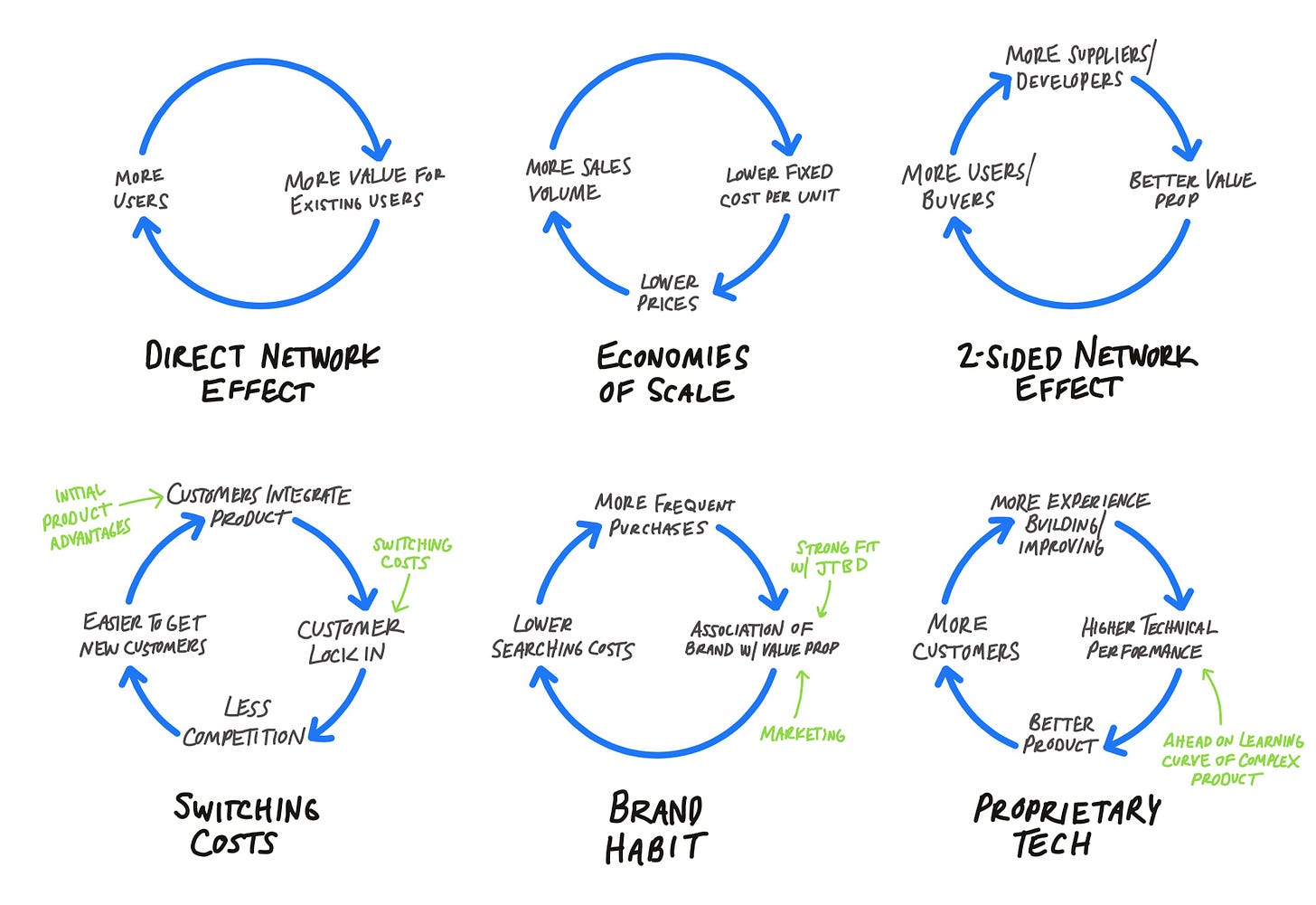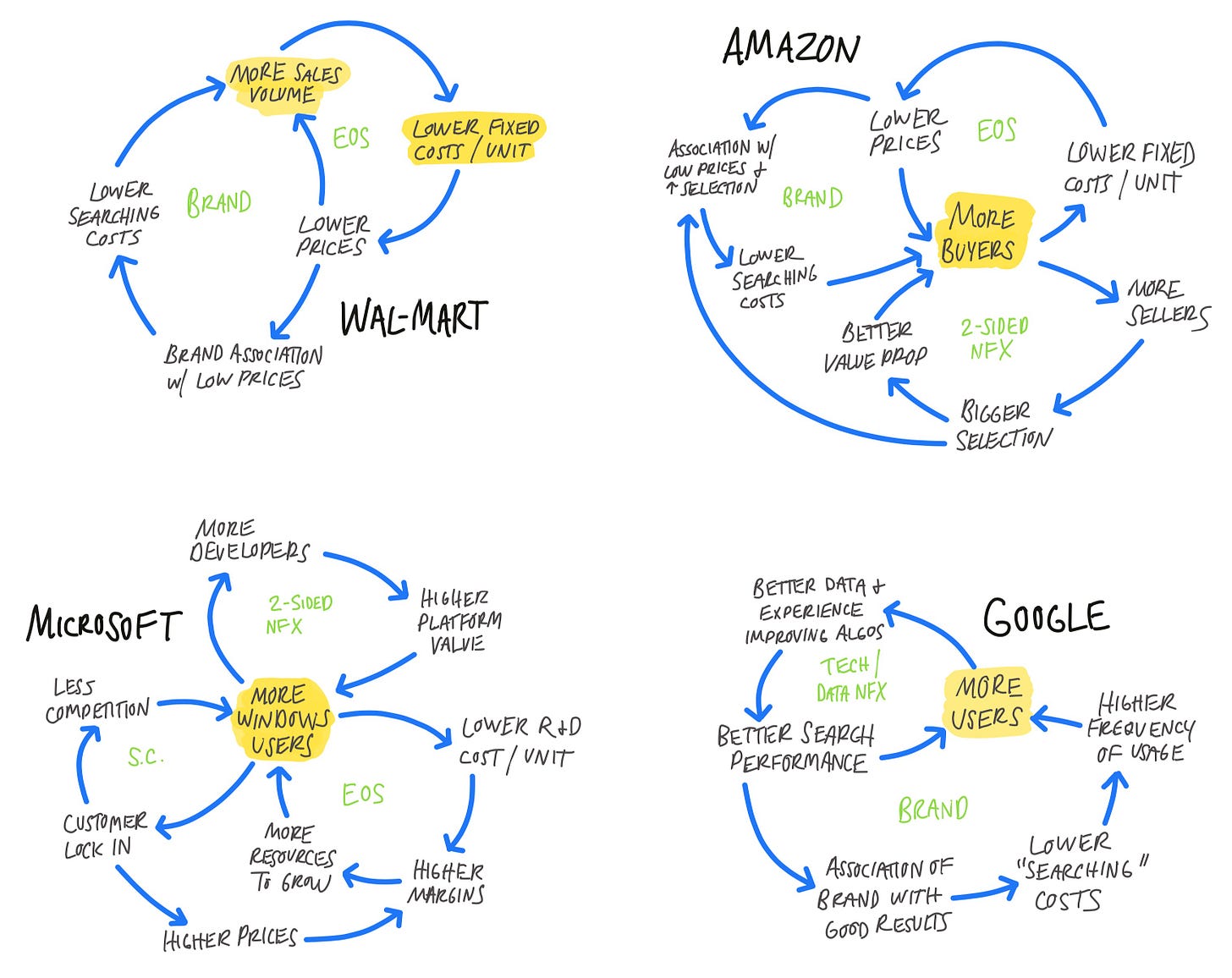Advantage Flywheels
Competitive advantage can be represented visually as 1 or more feedback loops. These create the advantage “flywheel” that maintain and grow a moat over time. Think of a big, heavy wheel that takes some effort to get started but then coasts off its own momentum.
Before continuing, check out Eric Jorgenson’s primer on the flywheel mental model here.
Flywheel archetypes
Here are 6 simple examples of common advantages represented as flywheels (or “causal loops” in systems terminology). These loops are generalized — they'll be expressed uniquely in every company that has them.
A few examples of how each advantage flywheel can vary:
In the Economies of Scale flywheel above, the primary driver of more volume is low prices. This fits for most consumer businesses, but lower prices aren't always the outcome of lower unit costs. If prices are maintained or increase, scale will yield higher margins → more resources to spend on growth → more sales volume.
The Brand Habit flywheel exhibits the typical loop for habit-reinforcing association of a brand with a specific quality or job-to-be-done. Think “thirst quenching happiness” for Coca-Cola and “low prices” for Wal-Mart. Another example of brand advantage is more of a social proof effect: Product has success → the cool kids want it → improved perception of product → ...
As Eric discussed in his flywheel post, each wheel needs a push to get started. Written in green on a few of the archetypes above are initial advantages to get the wheels moving. Whether it's a better user experience, a technical breakthrough, or a bootstrapped network based off of an existing network (college campuses for FB) or a useful utility (Instagram).
Real world examples
The above archetypes can be combined to create more comprehensive flywheels modeling the driving “engines” of each company's moat:
The most successful moats have multiple flywheels that feed off of each other’s momentum. Google’s technical advantages enable stronger brand allegiance and vice versa. Coca-Cola's marketing-driven brand feeds off of it’s distributor/bottler based network effects. Facebook’s brands have at least 3 reinforcing network effects: direct (social network), 2-sided aggregator (advertising and developers), and brand-driven social proof.
Friction and limiting factors
In systems thinking, reinforcing feedback loops are almost always slowed by a balancing loop attached to it. Growth doesn’t continue unchecked, and flywheels always run into friction.
Some of these limiting factors are overcome, others are so strong they stop or reverse the entire growth engine.
What are some typical examples?
Switching costs & network effects — product quality slips as the incentives to improve aren't strong when customers can't leave → value of a competitive offering overcomes switching cost.
Learning curve of proprietary tech — hitting top of the S-curve, output efficiency declines, and competitors catch up.
Direct network effects — any source of decreasing value to users, which could cause users to exit and turn the virtuous cycle into a vicious one.
Moats Move
Using the analogy of a feedback loop helps to think of an advantage as a moving, changing system. A system that needs catalysts to get started, and will gain momentum at first but still be slowed by friction over time.
When thinking about how a business will grow over time, ask:
What advantage archetypes does it fit?
Where are the sources of positive feedback?
How do you get the flywheels moving? What strategies can help get inertia? (For example, “doing things that don't scale.”)
What are the current or future limiting factors?
Thanks to Eric Jorgenson for feedback on the final version.
Featured photo from Ruth Hartnup on Flickr.




